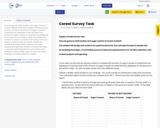
Surveying and Polling - Mathematics Instructional Plan
- Subject:
- Mathematics
- Material Type:
- Lesson Plan
- Provider:
- VDOE
- Author:
- VDOE
- Date Added:
- 10/07/2024

Surveying and Polling - Mathematics Instructional Plan

How are grocery shelf location and sugar content of cereals related? In this task, students visit two grocery stores to compare the amount of sugar in boxes of cereal that are displayed on the top shelf to the amount of sugar in boxes of cereal that are displayed on the second to the bottom shelf. They design and conduct a survey to compare their findings from two stores. In doing so, they encounter sample size, sampling technique, data collection, and
data analysis and reporting. Students compare their data in summary plots using two box and whisker plots. Students create a written report to share and relate findings to marketing decision making.

In small groups, students will be assigned two of the first ten amendments and pose the questions, “Which of these two amendments do you think is more important?” and “Why do you believe this?” in a survey of ten classmates. Then they will collect and organize the data electronically to create two visual representations of their information. Students will add their raw data and visualizations to a shared slideshow to present their findings to the class and explain why they chose this particular visualization model and what conclusions they can draw from their survey responses.This material is based upon work supported by the National Science Foundation under Grant No. 2010256.Any opinions, findings, and conclusions or recommendations expressed in this material are those of the author(s) and do not necessarily reflect the views of the National Science Foundation.

Students develop and solidify their understanding of the concept of "perimeter" as they engage in a portion of the civil engineering task of land surveying. Specifically, they measure and calculate the perimeter of a fenced in area of "farmland," and see that this length is equivalent to the minimum required length of a fence to enclose it. Doing this for variously shaped areas confirms that the perimeter is the minimal length of fence required to enclose those shapes. Then students use the technology of a LEGO MINDSTORMS(TM) NXT robot to automate this task. After measuring the perimeter (and thus required fence length) of the "farmland," students see the NXT robot travel around this length, just as a surveyor might travel around an area during the course of surveying land or measuring for fence materials. While practicing their problem solving and measurement skills, students learn and reinforce their scientific and geometric vocabulary.

This video is part of the Learn and Grow with WHRO TV series. Watch Amanda Knighton teach about creating and analyzing pictographs.